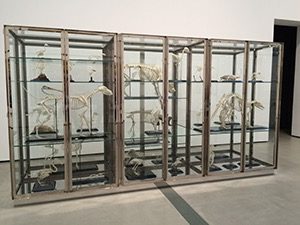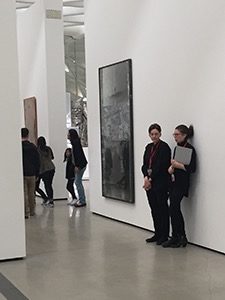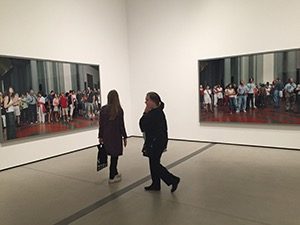On Being Heard
“The Broad’s No. 1 objective from the beginning was to connect a wide audience with contemporary art. To do that effectively, we had to think about how you can be truly welcoming and engaging in new ways.”
Joanne Heyler, Director, The Broad. “A New Kind of Museum Guard: Know-It-Alls in the Best Way,” New York Times (paywall), March 15, 2016
Before me was Damien Hirst’s Away from the Flock, a life-size lamb suspended in turquoise formaldehyde. Near me stood one of The Broad Museum’s Visitor Services Associates (VSA). I don’t remember being asked a direct question but something triggered my out-loud response, “Oh gosh, this thing is creepy.” Flat out, Away from the Flock is an example of Hirst’s work that always makes me shudder. The VSA confidently countered, “I don’t think it’s creepy.”
 My colleague Margie Maynard, who had walked up just in time to hear the exchange—and is an incredibly skilled art educator—stepped right into our conversation and asked the VSA, “What word would you use to describe it?” While slightly off-kilter because, for a moment, she no longer controlled the conversation, the VSA answered, “I think it’s provocative.” Not skipping a beat, Margie probed further, “Provocative of what? Just what does it provoke in you?” Short silence ensued then the VSA stated, “Empathy.”
My colleague Margie Maynard, who had walked up just in time to hear the exchange—and is an incredibly skilled art educator—stepped right into our conversation and asked the VSA, “What word would you use to describe it?” While slightly off-kilter because, for a moment, she no longer controlled the conversation, the VSA answered, “I think it’s provocative.” Not skipping a beat, Margie probed further, “Provocative of what? Just what does it provoke in you?” Short silence ensued then the VSA stated, “Empathy.”
These remarks kicked off a longer and worthwhile discussion wherein the VSA noted how she has observed that most people respond to the Hirst by expressing feelings for the lamb. As the VSA now had our attention, she continued to inform us about a related Hirst work in the gallery, describing it as a Louis Vuitton- style display case filled with animal bones. The skeleton closest to us happened to be from a dog. She said that from what she has observed, visitors tend not to express the same empathy towards the skeleton that they do towards the lamb.
As the VSA continued to talk I remained uneasy, feeling that my initial reaction of creepiness had been disregarded. Why hadn’t the VSA explored my reaction to help me sort through the creepiness? Her dismissal came too quickly, leaving me emotionally defensive. At this point her all-knowing words carried an undertone that either I wasn’t appreciating the radical nature of Hirst’s work or I didn’t know enough. Hirst’s pieces make me uncomfortable. Standing directly next to one intensified my reaction to the ambiguity of a dead animal. Was it real, or wasn’t it? All fodder for a good discussion because upsetting art can be meaningful.
After this exchange Margie and I moved on to another gallery where our professional museum educator perspectives took over and we talked about what had happened. I wasn’t just talking with any colleague about my experience with VSAs; Margie is currently the Director of Education at the Sonoma Valley Museum of Art, and was a pioneer of the VSA concept within art museums while she worked as the Director of Museum Experience and Education at the San Jose Museum of Art (SJMA). Throughout our visit, Margie and I had been, off-and-on, looking at the new galleries and watching how the VSAs were engaging visitors. Anyone with even the slightest bit of museum education training recognizes this duality between experiencing the gallery space as it is, while simultaneously thinking about how visitors are being supported.
That day I had five encounters with the VSA staff. Of these, one was during an orientation, two were side-by-side conversations with the art that VSAs initiated based on my audible responses about the art, and two were when I approached the VSA staff to ask specific questions. Both occasions where I initiated conversations the guides had been standing together talking, so I had to interrupt their in-house chat to connect.
Floor Staff Origins
After leaving the museum—which on the whole I’ll say was well worth the time and effort it took to get there—I asked Margie to refresh my understanding about the program she spearheaded at SJMA. Created in the early 2000s, her team’s effort signaled a new direction for art museum floor staff. The shift involved careful consideration about how this staff could support the day-to-day experiences visitors had when coming to their galleries. While the idea of paid floor staff designated to support the visitor was not a new idea to the broader museum field— paid Explainers at the Exploratorium had been around for decades—what was relatively innovative was having trained staff to serve in this capacity within art museums.
 A key factor in getting SJMA to move from a guard model to a visitor services one was that these new Museum Experience Representatives (SJMA’s version of VSAs) were a team whose job it was to support the visitor first and foremost. They also served as the eyes and ears for other staff so that the museum could gather more information about what was happening on the floor. The MERs also knew extensive amounts of information about the goings on within the museum, including such information as upcoming programs, what was on the menu in the café, and what items were being sold in the store.
A key factor in getting SJMA to move from a guard model to a visitor services one was that these new Museum Experience Representatives (SJMA’s version of VSAs) were a team whose job it was to support the visitor first and foremost. They also served as the eyes and ears for other staff so that the museum could gather more information about what was happening on the floor. The MERs also knew extensive amounts of information about the goings on within the museum, including such information as upcoming programs, what was on the menu in the café, and what items were being sold in the store.
Margie attributes the success of the SJMA model in part because it had been designed and managed within the museum’s experience and education department, which at the same time began to view the visitor experience using a holistic approach. As part of the effort to shift to MERs, the administrative team gathered data to decide how to effectively allocate staff resources so that the visitor experience would become so worthwhile that the museum’s attendance and membership numbers would increase. MERs were provided daily “hot sheets” of all that was happening at the Museum, and they had to turn in daily shift reports about what happened on the floor, which often included a reflection on an occurrence or an exchange that they had with a visitor, and more generally, how they or a fellow MER rocked the job on any particular day (actual wording on the reflection sheets!).
Margie made the point that not everyone can do the job—it was crucial to find the right people to become MERs. Their hires needed to know, or quickly learn, things like how to make eye contact, how to judge when to jump into a conversation, and intuit the moment to back off. They were part of a team that cared passionately about the visitor experience and willingly met the visitors where they were, in turn becoming joint conspirators in discovering art’s secrets. The people SJMA hired knew the language of getting everyone to “yes”, such that the VSAs could effectively move towards a visitor whose curiosity might be tempting them to touch a work of art and redirect their actions to a more appropriate means of discovery. Margie notes, “Art is just not as accessible in our culture because people are not as familiar with it, so in the galleries visitors tend to rely on the museum to guide the way. Most are not fully confident about what they are seeing; they haven’t a lot of experience trusting their own instincts. A good MER understands that knowing and sharing the expert’s, or even the artist’s view, is not the most important part of the job, instead it is to discover the visitor’s emerging curiosity and explore the visitor’s reactions to the art.”
Training Floor Staff
A month later I returned to The Broad and had a follow-up conversation with Lauren Girard, the Associate Director of Visitor Services, to talk about their training that involves 40 hours of online material contained in modules on a Learning Management System (LMS). The LMS had just won a Bronze GLAMi Award from Museums and the Web (training structure overviewed here). Training is critical to the VSA program, at any one time there can be 60-80 VSAs on the floor at The Broad. Per their website, the job seems to be part-time, and as Lauren tells me, pays a ‘Living Wage,’ as translated in this document as a baseline of $11.17 + $1.25 per hour in Health benefits (through June 2016). While I have not done an extensive study, I sense that these wages are quite typical for these positions These low wages are frustrating because they should match the skills needed to do the job well; and I can imagine that it will be difficult to recruit, train and retain this large team. Still with that many VSAs on the floor at any given time, The Broad has made a significant contribution to staff-to-visitor exchange in the galleries.
 While there are clearly advantages to creating a consistent and resource-rich set of training materials for any job—and no doubt this a smart new direction with training—I wonder: can empathy and listening skills be taught through video? Is modeling carefully crafted visitor/staff encounters enough, or does this skill require practice listening to and talking with actual visitors in order to support their reactions to the art?
While there are clearly advantages to creating a consistent and resource-rich set of training materials for any job—and no doubt this a smart new direction with training—I wonder: can empathy and listening skills be taught through video? Is modeling carefully crafted visitor/staff encounters enough, or does this skill require practice listening to and talking with actual visitors in order to support their reactions to the art?
Lauren explained that The Broad’s team has iterated several training configurations, from small group work accompanying the individual online modules, to only using the online material, to the current iteration of supplementing the LMS with small groups because the discussions amongst VSAs seems to matter in peer training. Lauren and I spoke extensively about the challenge to effectively craft the conversation between the visitor, the art and the VSA. She stressed that they model effective visitor approaches during discussions and the training structure link has a screen shot of a section called, Recognizing Cues, How to Anticipate Visitor Needs. Many Broad VSAs have existing art training though this is not a top requirement. Several guides I talked to in the galleries explained that they often have discussions amongst themselves about the kinds of questions and reactions that visitors have with works of art. If these conversations could get captured and vetted, I imagined these insights would be useful, integrating real visitor reactions into their online training.
My more negative experience with a VSA concerned Lauren because as a seasoned visitor services professional she acknowledged negative experiences are often remembered and talked about afterwards—as this post shows. I now suspect my exchange about the Hirst had to do with my contrary reaction to it and the VSA was prodding me to be open to the work, with the intention of helping me to have a more positive experience.
The Challenge of Training Staff to Hear
The VSA training challenge is significant: knowing how to support visitors, no matter where they are in relation to a work of art, isn’t an easy, instant skill to master. It takes significant, direct practice and analysis to learn how to negotiate these conversations, to exercise good judgment about when to step in, and perhaps venture in with people who are essentially strangers, and when to bow out. Real-time training experiences, along with reflection about how well various conversation strategies work, make huge a difference. Listening with empathy and finding a way to walk alongside visitors for a short time is imperative. I needed The Broad’s VSA to support my unease when I reacted to Away from the Flock. Ideally next time, I’ll be heard out.
Editors’ Note: The current issue of the Journal of Museum Education tackles new approaches to guide and docent training.
Susan Spero teaches Museum Studies at the John F. Kennedy University. In her earlier career she served as a Docent Coordinator for two art museums. She has great empathy for those who train, support and guide interpretive staff.
Photo credits: (1) Away from the Flock, Damien Hirst, 1994, from www.thebroad.org/art/damien-hirst/away-flock, (2) Susan Spero, (3) & (4) Margie Maynard.

